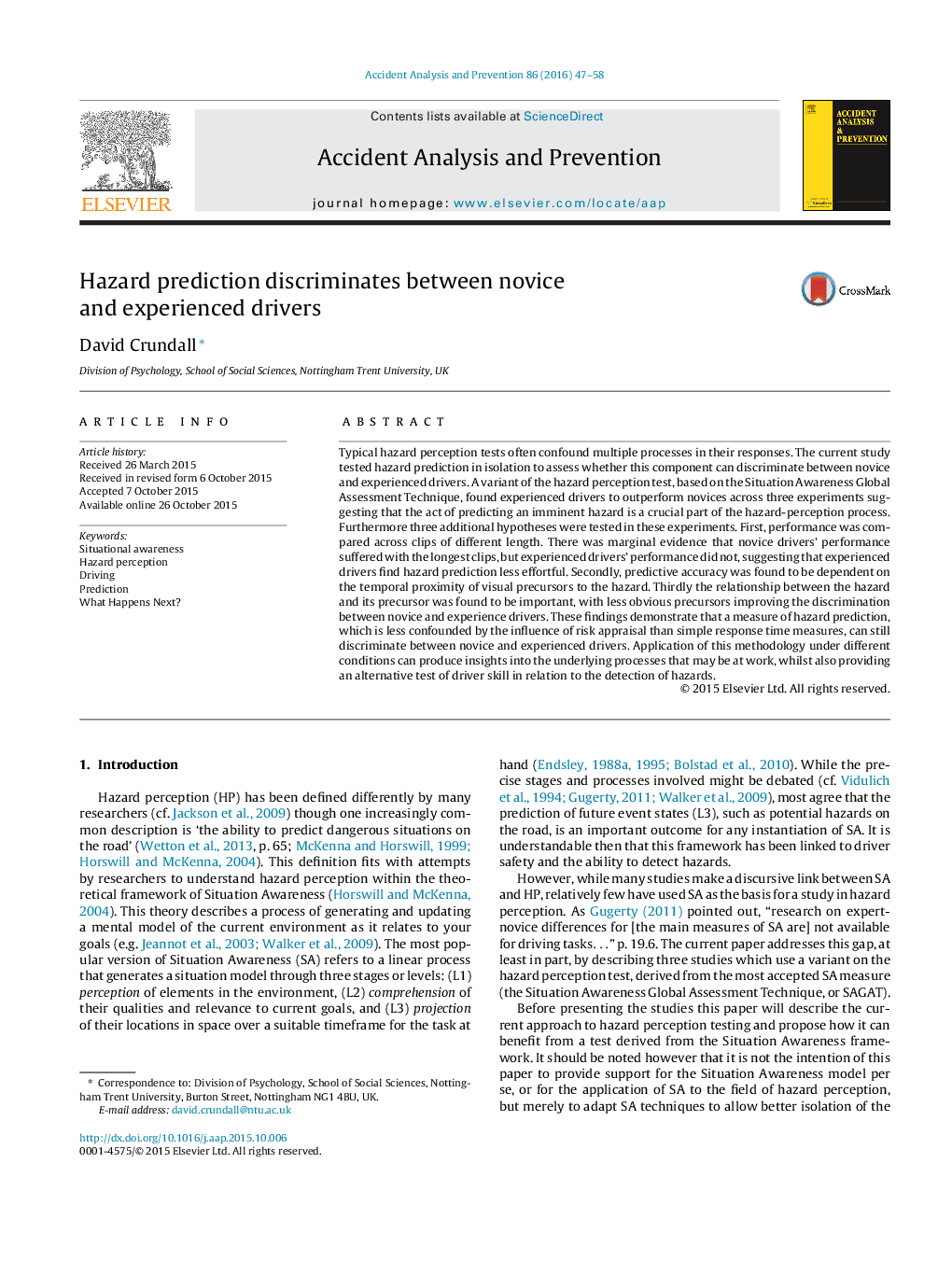| کد مقاله | کد نشریه | سال انتشار | مقاله انگلیسی | نسخه تمام متن |
|---|---|---|---|---|
| 6965398 | 1452911 | 2016 | 12 صفحه PDF | دانلود رایگان |
عنوان انگلیسی مقاله ISI
Hazard prediction discriminates between novice and experienced drivers
ترجمه فارسی عنوان
پیش بینی خطر بین نوازندگان و رانندگان با تجربه متفاوت است
دانلود مقاله + سفارش ترجمه
دانلود مقاله ISI انگلیسی
رایگان برای ایرانیان
کلمات کلیدی
آگاهی وضعیتی، درک مخاطره، رانندگی، پیش بینی، بعد چه اتفاقی می افتد؟،
ترجمه چکیده
تست ادراک خطر معمول اغلب در پاسخ های خود چندین فرایند را مختل می کند. این مطالعه پیش بینی خطر را به صورت جداگانه مورد آزمایش قرار می دهد تا ارزیابی کند که آیا این مولفه می تواند بین نوازنده ها و رانندگان با تجربه متفاوت باشد. یک نوع از آزمون تصور خطر، بر اساس تکنیک ارزیابی جهانی آگاهی از وضعیت، رانندگان با تجربه را در اختیار تازه کاران در سه آزمایش قرار دادند که نشان می دهد اقدام پیش بینی یک خطر غیرقابل پیش بینی، بخش مهمی از فرایند ادراک خطر است. همچنین در این آزمایشات، سه فرضیه اضافی مورد آزمایش قرار گرفتند. اول، عملکرد در کلیپ های مختلف طول مقایسه شده است. شواهد حاشیه ای وجود دارد که عملکرد رانندگان تازه کار با طولانی ترین کلیپ ها رنج می برد، اما عملکرد رانندگان با تجربه مواجه نشد، که نشان می دهد که رانندگان با تجربه خطرناکی را پیش بینی می کنند. ثانیا، دقت پیش بینی شده بستگی به نزدیک بودن زمان پیش بینی های بصری به خطر دارد. ثالثا ارتباط بین خطر و پیش ساز آن مهم است، با پیش آگهی های کم اهمیت تر، تبعیض بین رانندگان تازه کار و تجربه را بهبود می بخشد. این یافته ها نشان می دهد که اندازه گیری پیش بینی خطر، که از طریق تأثیر ارزیابی ریسک نسبت به اندازه گیری زمان پاسخ ساده کاهش می یابد، هنوز هم بین رانندگان تازه کار و با تجربه تفاوت دارد. استفاده از این روش در شرایط مختلف می تواند بینش های مربوط به فرآیندهای اساسی را که ممکن است در محل کار باشد، تولید کند، در حالی که تست جایگزین مهارت راننده در ارتباط با تشخیص خطرات را نیز ارائه می دهد.
موضوعات مرتبط
مهندسی و علوم پایه
مهندسی شیمی
بهداشت و امنیت شیمی
چکیده انگلیسی
Typical hazard perception tests often confound multiple processes in their responses. The current study tested hazard prediction in isolation to assess whether this component can discriminate between novice and experienced drivers. A variant of the hazard perception test, based on the Situation Awareness Global Assessment Technique, found experienced drivers to outperform novices across three experiments suggesting that the act of predicting an imminent hazard is a crucial part of the hazard-perception process. Furthermore three additional hypotheses were tested in these experiments. First, performance was compared across clips of different length. There was marginal evidence that novice drivers' performance suffered with the longest clips, but experienced drivers' performance did not, suggesting that experienced drivers find hazard prediction less effortful. Secondly, predictive accuracy was found to be dependent on the temporal proximity of visual precursors to the hazard. Thirdly the relationship between the hazard and its precursor was found to be important, with less obvious precursors improving the discrimination between novice and experience drivers. These findings demonstrate that a measure of hazard prediction, which is less confounded by the influence of risk appraisal than simple response time measures, can still discriminate between novice and experienced drivers. Application of this methodology under different conditions can produce insights into the underlying processes that may be at work, whilst also providing an alternative test of driver skill in relation to the detection of hazards.
ناشر
Database: Elsevier - ScienceDirect (ساینس دایرکت)
Journal: Accident Analysis & Prevention - Volume 86, January 2016, Pages 47-58
Journal: Accident Analysis & Prevention - Volume 86, January 2016, Pages 47-58
نویسندگان
David Crundall,
